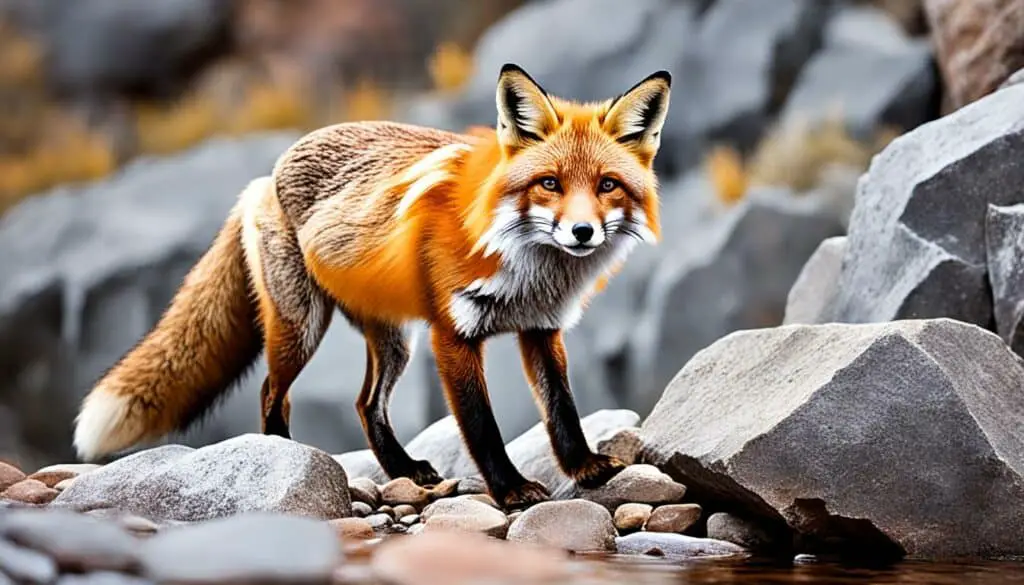Have you ever wonder how red foxes survive in different places? They can live everywhere from the low sea to high mountains, up to 3000 meters. Red foxes prefer areas that mix scrub, woods, and farms.
In Eurasia and North America, red foxes do well thanks to what humans do. Activities like cutting forests for farms and adding new game animals help them. They are successful because they are good at finding food and surviving.
Overview of Red Fox Habitats
The red fox (Vulpes vulpes) is very adaptable, making it thrive in many places. They can live where scrub, woodland, and farmland meet, finding shelter and food. The red fox’s behavior in these areas is key to its success in different places.
In places with little food, like thick forests and mountains, there are fewer red foxes. This is because food is hard to find. However, the red fox does well in areas changed by people. Here, more game animals mean more food for the foxes.
Looking at how red foxes act in different homes shows a lot. They do best in varied areas because they can hunt well and find good spots for their young. Their ability to live in many places has made them one of the most common meat-eaters on Earth.
| Habitat Type | Characteristics | Red Fox Adaptation |
|---|---|---|
| Mixed-use Landscapes | Combines scrub, woodland, and farmland | Provides shelter, prey diversity, and breeding sites |
| Dense Woodlands | Limited food supply, high seasonality | Lower population density |
| Mountain Ranges | Challenging conditions, food scarcity | Utilizes keen survival instincts |
| Human-altered Landscapes | Introduction of game species | Population boost |
Mixed Landscapes: Scrub, Woodland, and Farmland
Red foxes love places with lots of different resources. They are found hunting and living in scrub, woodland, and farmland environments.
Scrub Areas
In areas with thick scrubs, red foxes find everything they need. They have lots of hiding spots, plenty of food, and safe places for their young. The dense undergrowth helps keep their activities hidden.
Woodland Environments
Older, mature woodlands are great for daytime rests. Even though there might be fewer animals to eat, red foxes can still find food by exploring nearby areas. They might share food with other hunters, like the tawny owl, but they can handle it.
Farmland Advantages
Farmlands with bits of woods are ideal for red foxes. They offer many chances to hunt and a diverse diet. Red foxes eat a lot of small animals like rabbits and fruit. They also sometimes eat dead animals they find.
| Habitat | Key Benefits | Challenges |
|---|---|---|
| Scrub Areas | Shelter, diverse food sources | Competition for resources |
| Woodland Environments | Daytime resting, foraging opportunities | Lower prey density, predator competition |
| Farmland | Ample hunting opportunities, varied diet | Human encroachment, habitat alteration |
Urban Environments
In cities worldwide, the urban red fox is now a familiar sight. It thrives in these urban areas thanks to its ability to adapt and find resources. Foxes make their homes in gardens, parks, and waste grounds. Here, they find food and shelter, creating a unique urban habitat for them.
Benefits of Urban Living
Urban environments bring many benefits for red foxes. They find a wide range of food: from small animals and birds to fruits and human leftovers. As a result, they can live together in larger groups in cities. They do not have as many natural predators in cities either. So, they can live more freely.
Challenges in Urban Areas
However, life in the city is not always easy for red foxes. They face diseases like mange and sometimes have to deal with people. Being hit by cars is a real danger for them. They also have to share their living space with domestic pets. This can be stressful for them.
Examples of Urban Adaptation
Red foxes show they can adapt well to city life. For instance, there are stories of foxes living near places like Yankee Stadium. They move easily from city to countryside, blurring the lines between types of fox populations. This shows they are very adaptable in a changing world.
High Altitude Regions
Red foxes are amazing animals that live in many places, including high up. Most animals stay at lower levels, but the red foxes go high up into the mountains. They do well even though it’s tough up there with little food and hard weather.
The red foxes show how flexible they are by living in rocky areas and dealing with cold climates. They eat things like small animals and birds that also live up high. This helps them to cope with the challenges of their surroundings.
Because food is scarce and the environment is harsh, not many red foxes live in those areas. But the ones that do are very smart and find ways to keep themselves fed. They scavenge for food and hide some for later, showing their cleverness.
Their ability to subsist in such demanding conditions is a testament to the red fox’s resilience and flexible approach to survival strategies.

Studying the red fox’s home in the high mountains provides insights into their success. They have shown they can live in many places, not just in the woods. This proves how adaptable and smart they are, helping them live around the world in many different areas.
Coastal Dunes and Marine Areas
Red foxes use coastal dunes and marine areas all year. They change their ways based on the season. This makes them expert at finding food and shelter in these places.
Seasonal Use of Coastal Habitats
When seabirds and other prey are around, red foxes head to the coast. They take advantage of the food near the dunes and the sea. This shows how they’ve learned to survive by focusing on where they can find the most food at different times.
Prey Availability in Coastal Areas
What they eat in the coastal areas really matters to red foxes. They can easily switch to eating fish and birds when these are abundant. This change shows how well they can adjust during certain times, like when seabirds are laying eggs or when other coastal animals have their young.
Marquis and Scrubwood Habitats
Red foxes love marquis and scrubwood areas. They like the thick plants and changing seasons to live well and find food. These places are vital for the red fox ecosystem. They help with the foxes’ home areas and where they live throughout the year.
Seasonal Preferences
In the cooler times, red foxes really prefer marquis and scrubwood places. The thick plants there keep them safe from the cold. This shows how the red fox ecosystem changes with the seasons and their needs. They use the season’s elements to stay safe and eat.
Adaptations to Scrubwood Areas
In scrubwood spots, red foxes can find a mix of open meadows and pine woods. It’s a good balance for finding food and hiding. This mix in the red fox territory allows them to use the land in different ways. They are great at living and growing in these places, no matter how tough it might be.
Open Country and Flatlands
Open country and flatlands are usually seen as not ideal for red foxes. They lack enough hiding spots and varied food sources. This makes it hard for red foxes to live well in these areas, especially when there’s a lot of farmland and fences.
But red foxes are really good at adapting. They use their smarts and are always looking for food. This way, they can make it work in places that might not seem perfect for them. Their ability to survive in many different types of places is quite impressive.
Red Fox Distribution in Indiana
The red fox has a unique story in Indiana. It’s thought to have come with European settlers during the mid-1800s. Not from the region originally, it now lives widely across the state. Its ability to adapt lets it live in various places, such as rural, suburban, and urban areas.
History of Red Foxes in Indiana
Initially, red foxes were not from Indiana. They arrived with European settlers, taking advantage of the changing land. As forests were cut down for farming, they found more space to live. This led them to spread all over the state, becoming a big part of Indiana’s wildlife.
Current Distribution Across Counties
Today, red foxes are in every county in Indiana. They can live in many places, from scrub and woods to farms. Their success shows how well they adapt to different environments. They are not just in the wild but also in cities and suburbs. You can find them in city parks, gardens, and even in urban areas with many people.
In short, red foxes in Indiana are a great example of adapting and thriving. When you visit Indiana, notice the many places these smart animals make their home.
FAQ
What types of habitats do red foxes prefer?
Red foxes love places that bring together scrub, woodlands, and farms. These areas give them a safe place, a wide choice of food, and spots to have their babies. They can be happy in many different places, from low lands to high mountains, up to 3000 meters.
What is the natural habitat of red foxes?
For red foxes, a perfect home is a mix of forests, scrub, and farmlands. This mix lets them find good hiding spots, build their homes, and catch their meals. It’s why you can see them all over the place in Europe, Asia, and North America.
How do red foxes adapt to their environments?
Red foxes know how to live in many different places. They eat whatever’s around, find safe spots to sleep, and change how they hunt to fit what’s there.
How does red fox behavior vary across different ecosystems?
Red foxes act differently depending on where they are. In the woods, they sleep during the day and hunt in clearings at night. In cities, they might be busy during the day to avoid people and find food in human garbage.
What is the significance of mixed landscapes for red fox habitats?
Places that mix scrub, woods, and farmlands are key for red foxes. They offer a bit of everything – a place to hide, food to catch, and space to avoid bigger hunters. These regions are perfect for fox families too.
Why do red foxes thrive in scrub areas?
Scrub areas are great for red foxes because they have lots of places to hide and things to eat. The different sizes and ages of trees help them find food and build their homes, which is very important for their lives.
How do red foxes use woodland environments?
Red foxes like to sleep in deep forests and hunt in open areas next to them. They do this because there’s more food and fewer other hunters out there.
What advantages do farmlands provide to red foxes?
Farms are huge buffet grounds for red foxes. They find all kinds of food, from small animals like rabbits to fruits. These mixtures of fields and forests are perfect for their survival.
What are the benefits of urban living for red foxes?
The city is a treasure chest for red foxes. They find food and shelter in gardens and parks. This has made them do really well in cities, more than in the countryside.
What challenges do red foxes face in urban areas?
Living in the city isn’t easy for red foxes. There’s a risk of getting sick and they might not get along with people. But they’re very smart and find ways to live there safely.
How do red foxes demonstrate urban adaptation?
Red foxes have shown they can live in the heart of cities, like at Yankee Stadium. This shows they do just as well in the city as they do in the wild, surprising many researchers.
Can red foxes live at high altitudes?
Yes, red foxes can make homes even in very high mountains. Even though it’s tough, they are really good at surviving in these hard places.
How do red foxes use coastal habitats seasonally?
Red foxes love coastal areas when there’s a lot to eat, like seabirds. They focus their hunting near the water to catch the extra food there.
What role does prey availability in coastal areas play for red foxes?
Food by the coast changes where red foxes like to live. When seabirds and other ocean creatures are having babies, red foxes eat more marine food.
What are the seasonal preferences of red foxes in marquis and scrubwood habitats?
In cold months, red foxes prefer places with thick plant life, like marquis and scrubwood. It keeps them warm and protects them from the weather.
How do red foxes adapt to scrubwood areas?
For red foxes, scrubwood areas should have both open fields and forests. This mix is perfect, giving them food and a place to hide, making it a great home for them.
Do red foxes prefer open country and flatlands?
Red foxes don’t like places that are too open or too flat. They need places with lots of hiding spots and food choices. Even so, they can still live in those areas because they’re so resourceful.
What is the history of red foxes in Indiana?
In Indiana, red foxes probably came with the first European settlers around the 1800s. Now, they are found all over the state, even in big cities.
How are red foxes currently distributed across Indiana counties?
Red foxes can be found everywhere in Indiana today. They especially like places where woods and fields meet. This shows how well they fit in and do well in many different places.







